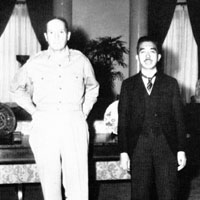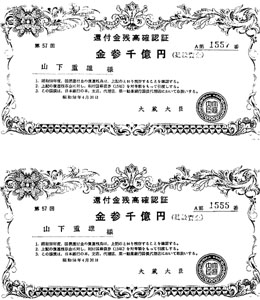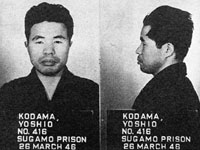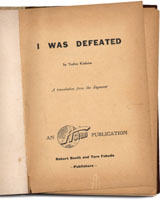True Lies
Back to Contents of Issue: April 2004
|
|
|
|
by David McNeill |
|
|
When World War II ended and the Allied forces, under General Douglas MacArthur, surveyed the wreckage from the Imperial Army's rampage across Asia, they uncovered evidence of enormous quantities of money, precious metals and treasure stolen mainly from Taiwan, China, Korea and the Philippines. It included tons of gold from the treasury of Chinese nationalist leader Chiang Kai-shek, assets from the British, French, American and British colonial authorities, gilt from Buddhist temples across the region and millions in gems, foreign currencies and precious art, plundered, according to some accounts, under the direct supervision of members of the Imperial Household, including Emperor Hirohito's brother, Prince Chichibu.
Where this booty ended up is the subject of a recent and bracingly well-documented book by Sterling and Peggy Seagrave called Gold Warriors: America's Secret Recovery of Yamashita's Gold -- which includes a note from the authors listing the precautions they have taken should they be murdered. (One example: The authors say they have posted the entire book and its research documentation at various Internet sites to ensure its preservation).
The Seagraves report the shipment of huge hoards of gold to Japanese-occupied Malaya and later the Philippines. The shipments were melted down and buried with other treasure in 175 storage sites -- along with thousands of slave laborers, soldiers and even officers who were buried alive in an effort to keep the burial locations secret.
Most of the rest was lost or destroyed in Allied bombings, but the authors say an enormous amount survived the war. The Yamashita treasure was named after General Tomoyuki Yamashita, the Japanese wartime commander in the Philippines, where it is legendary. Agents of the Office of Strategic Services (OSS), the forerunner of the CIA, found the loot in the Philippines, which was later inspected by General MacArthur himself and senior U.S. political figures, who agreed to keep the treasure off the official books.
But here is where the story really gets interesting.
According to the Seagraves, the wealth was stashed in banks around the world and used throughout the postwar years by the CIA to manipulate politics everywhere from Greece to Nicaragua, essentially stacking the odds in favor of those sympathetic to American interests and against the forces of the left. Much of this history of postwar clandestine CIA activity is now thoroughly documented and largely uncontested, thanks to the work of Frances Stoner Saunders, Seymour Hersh and others, and in Japan, to Michio Matsui, Alec Dubro, David E. Kaplan and Johnson himself.
But the suggestion that the plundered wealth of 12 Asian countries underwrote this activity is not. Nor is the allegation that part of the loot was used to kick-start the crippled economy of the very country that stole it.
The notion that the seed funds for Japan's economic "miracle" were provided by the countries it invaded is controversial enough -- especially considering the stingy amounts of war compensation Tokyo has paid to its former victims over the years. But there is more.
As US priorities changed, other uses for the fund were found. SCAP enthusiasm for the remaking of Japan, the complete destruction of its military forces and the protection of its new "pacifist" constitution had started to wane, even by the late 40s, as communists took power in China. When US troops were sent to fight the Korean War in 1950, the fund was secretly used to create the National Police Reserve, the predecessor of today's Self-Defense Forces, to fill the security vacuum in Japan. Within the context of the bitterly contested signing of the Treaty of Mutual Cooperation and Security in 1960, the fund passed into exclusive Japanese control (thanks to then Vice President Richard Nixon, who allegedly negotiated its transfer in return for cash infusions into his campaign).
Since then, and beginning with Prime Minister Nobusuke Kishi, the fund has, in the words of the now-deceased Schlei, "been treated as the private preserve of the individuals into whose control it has fallen," and has grown, he claims, from $35 billion to over $500 billion today. The individuals, all affiliated with the Liberal Democratic Party, are said to include former prime ministers Kakuei Tanaka, Eisaku Sato and Yasuhiro Nakasone. The fund has been used to bankroll the LDP, fend off political challengers (including the funding of a private right-wing army to crush protests against the 1960 US-Japan treaty), and to enrich themselves. Kishi allegedly emerged one trillion yen (then nearly $3 billion) richer, thanks to his proximity to the loot. Tanaka siphoned off even more, and numerous other figures have emerged with sticky fingers from the M-Fund pie. Schlei's observations, written over 10 years ago, bear repeating: "The secrecy surrounding the M-Fund and the absence of governmental or institutional controls over it have led to abuses so great as to dwarf any governmental scandal within memory in any part of the world .... It is not too much to say that the M-Fund, controlled as it is by individuals free of any significant governmental or institutional restraints, has prevented Japan from becoming a truly democratic country .... The enormous money power [of the fund] has prevented the development of political parties able to compete with the Liberal Democratic Party."
Certainly allegations of CIA manipulation of the domestic political process in Japan, once dismissed as conspiracy talk, were proved conclusively by revelations in the US media in the mid-90s that large sums of money had indeed been funneled to the LDP to strengthen their grip on power. A large number of historians and investigative journalists working in Japan have heard of the M-Fund, and many concur that there is at least a "core of truth" to it (see sidebar).
Not surprisingly given this secrecy, the M-Fund has become a staple of bad conspiracy thrillers and racy weekly magazines in Japan, a topic used to spice-up limp narratives or weak stories. But it has also over the years been the subject of serious articles by the Asahi and Yomiuri newspapers and a number of books by investigative journalists. It has been linked to several alleged murders, including Kakuei Tanaka's driver, an assistant to political kingmaker Noboru Takeshita and, astonishingly, to former Prime Minister Sato. But like so much of the postwar Japanese political landscape, the M-Fund remains in the shadows: There has never been a full and open accounting of where the money came from or where it went.
Woven into the story of the M-Fund is the fate of several Japanese war criminals who escaped the noose thanks to the post-1948 shift in American priorities. The key private figure involved in what Johnson calls the "looting of Asia" was the notorious Yoshio Kodama, a rich and fanatical ultra-nationalist with connections to both the underworld and some of Japan's most famous postwar political figures. Kodama's history is now fairly well known, mainly thanks to David E Kaplan and Alec Dubro's seminal Yakuza, and Kodama himself was more than happy to talk about his experiences at great length.
These accounts make clear how, despite his appalling war record, Kodama went on to become a key CIA fixer in Japan, carving out a long and undistinguished career involving bribery, corruption and the sponsorship of both the yakuza and one-party LDP rule. (One of many schemes in which he was involved was the infamous "Lockheed Scandal," in which Kodama was given a $2.1 million bribe to ease the US aircraft weaponry corporation's entry into the Japanese market.)
Kodama died in 1984. A fellow inmate, Nobusuke Kishi, who oversaw Japan's wartime slave labor program, was also rehabilitated by the US authorities and, according to well-established accounts, secretly supported as a "safe" conservative by CIA money during the crucial 58-60 period, ensuring the continuation of one-party rule.
This account barely scratches the surface of the M-Fund account and the nature of its reverberations in Japan and elsewhere, even today. What was the extent of the Imperial family's involvement? How many hundreds of private individuals became rich thanks to their connection to the fund? And to what extent were democratic politics impoverished in scores of countries as a result?
A large number of people who came into contact with the fund were consumed by the heat it generated. Take the career of Schlei, who did much to expose the fund's tangled history.
On February 12 of this year, Finance Minister Sadakazu Tanigaki nervously fended off DPJ questions about a "JPY380 trillion M-Shikin" during a Diet debate. The debate ended with a vague promise from Tanigaki to "look into it." Remember all this the next time you hear a politician bemoaning the rise of foreign crime in Japan.
@ |
|
Note: The function "email this page" is currently not supported for this page.


 It sounds like the plot of an overwrought political thriller, the sort of thing Oliver Stone might cook up if he cast his conspiratorial gaze toward Japan. But the story of the M-Fund (named after US Major General William Marquat, the fund's initial overseer) has attracted some heavyweight researchers, including Chalmers Johnson, a former CIA consultant, and Norbert A. Schlei, assistant Attorney General during the Kennedy Administration. It goes like this.
It sounds like the plot of an overwrought political thriller, the sort of thing Oliver Stone might cook up if he cast his conspiratorial gaze toward Japan. But the story of the M-Fund (named after US Major General William Marquat, the fund's initial overseer) has attracted some heavyweight researchers, including Chalmers Johnson, a former CIA consultant, and Norbert A. Schlei, assistant Attorney General during the Kennedy Administration. It goes like this.
 With one-quarter of Japan's national wealth consumed by the war and the forces of left and right vying for power, the Seagraves claim the Supreme Commander of Allied Powers (SCAP) used the stolen wealth as the basis of a sort of Japanese Marshall Plan for establishing a stable democracy -- but also to fund and develop key industries such as coal, iron, shipbuilding and electric power.
With one-quarter of Japan's national wealth consumed by the war and the forces of left and right vying for power, the Seagraves claim the Supreme Commander of Allied Powers (SCAP) used the stolen wealth as the basis of a sort of Japanese Marshall Plan for establishing a stable democracy -- but also to fund and develop key industries such as coal, iron, shipbuilding and electric power.
 But many also cite the lack of available evidence to firmly establish its veracity. The problem, they say, is that documentation covering the murky deals struck between Tokyo and Washington during a period of intense Cold War activity remain sealed in US archives. "The US could clear this up but they've refused to declassify a whole bunch of documents from the 50s and 60s," says Financial Times journalist Gillian Tett, who spent months of "frustrating" work researching the fund. "The real story for me is why have the conditions been laid for so many conspiracies to flourish. And that's because US-Japan relations are filthy. There are so many dark areas."
But many also cite the lack of available evidence to firmly establish its veracity. The problem, they say, is that documentation covering the murky deals struck between Tokyo and Washington during a period of intense Cold War activity remain sealed in US archives. "The US could clear this up but they've refused to declassify a whole bunch of documents from the 50s and 60s," says Financial Times journalist Gillian Tett, who spent months of "frustrating" work researching the fund. "The real story for me is why have the conditions been laid for so many conspiracies to flourish. And that's because US-Japan relations are filthy. There are so many dark areas."
 Schlei became involved though his work as a lawyer with mysterious bonds that the Japanese government claimed were forgeries. Schlei and others contended that the bonds were issued by the MOF to conceal the huge amounts of cash sloshing around Tokyo. After a legal battle, Schlei was pursued by the FBI -- then given a five-year suspended sentence in 1995 on what many call trumped up charges for handling the "fake" bonds. Schlei died last year, his life destroyed, say his supporters, because he got too close (see sidebar).
Schlei became involved though his work as a lawyer with mysterious bonds that the Japanese government claimed were forgeries. Schlei and others contended that the bonds were issued by the MOF to conceal the huge amounts of cash sloshing around Tokyo. After a legal battle, Schlei was pursued by the FBI -- then given a five-year suspended sentence in 1995 on what many call trumped up charges for handling the "fake" bonds. Schlei died last year, his life destroyed, say his supporters, because he got too close (see sidebar).



